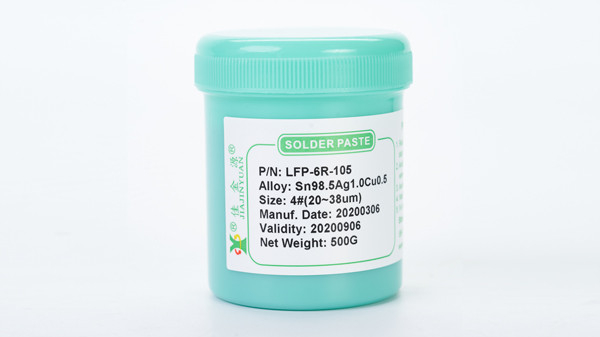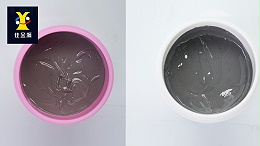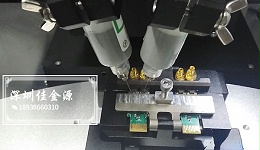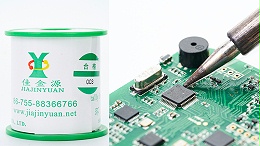
Lead-free solder pasteinSMTIt is widely applied in the processing and manufacturing process, and withRoHSThe popularization of standards has replaced leaded solder paste as the mainstream. However, lead-free solder paste does not represent0%The lead content. Solder paste is an alloy-composed paste. The appropriate composition formula is decisive for the overall soldering quality of the circuit boardMeaning.
Lead-free solder paste does not mean that the presence of lead in the solder paste is absolutely and completely prohibited. It only stipulates that the lead content must be reduced to below1000ppm(<0.1%)The level of this also means that electronic manufacturing must meet the requirements of lead-free assembly processes. "Electronic lead-free" is also often used to generally refer to six toxic and harmful materials including leadThe content must be controlled at1000ppmWithin the level.

In lead-free solder paste, the main component is tin/silver/Copper is composed of three parts, with silver and copper replacing the original lead component. The fundamental characteristics and phenomena lie in tin/silver/In the copper system, tin is a minor element(Silver and copper)The metallurgical reaction between them is the main factor determining the application temperature, curing mechanism and mechanical properties. According to the binary phase diagram, there are three possible binary eutectic reactions among these three elements. A reaction between silver and tin is in221°CThe eutectic structure that forms the tin matrix phase andεThe chemical phase between metals(Ag3Sn). Copper reacts with tin227°CThe eutectic structure that forms the tin matrix phase andηThe chemical phase between metals(Cu6Sn5). Silver can also react with copper779°CForm rich silverαHarmonious and rich in copperαA phase eutectic alloy. However, in the current research1For tin/silver/The measurement of the curing temperature of copper triplet compounds in779°CNo phase transition was found. This indicates that it is very likely that silver and copper react directly in the triple compound. And in terms of temperature kinetics, it is more suitable for the reaction between silver or copper and tin to formAg3SnorCu6Sn5Compounds between metals. Therefore, tin/silver/The copper triple reaction can be expected to include the tin matrix phase.εThe chemical phase between metals(Ag3Sn)andηThe chemical phase between metals(Cu6Sn5).
And biphasic tin/Silver and tin/As confirmed by the copper system, it is relatively harderAg3SnandCu6Sn5 The tin particles in the tin matrix/silver/In copper triple alloys, the alloy can be effectively strengthened by establishing a long-term internal stress. These hard particles can also effectively prevent the spread of fatigue cracks.Ag3SnandCu6Sn5The formation of particles can separate smaller tin matrix particles.Ag3SnandCu6Sn5The smaller the particles are, the more effectively the tin matrix particles can be separated, and the result is a finer microstructure as a whole. This contributes to the sliding mechanism at the particle boundaries, thereby prolonging the fatigue life at elevated temperatures.
The main components of lead-free solder paste are tin, silver and copper, with silver and copper replacing the original lead component.
In the composition of alloy components, alloysSn95.4Ag3.1Cu1.5It is considered the best. Its excellent performance is the result of the formation of fine microstructures, which provide high fatigue life and plasticity. For0.5~0.7%Solder alloys of copper, any higher than approximately3%The silver content of all will increaseAg3SnThe particle volume fraction is reduced, thereby achieving a higher intensity.
Although the specific formulations of silver and copper in alloy design are crucial for obtaining the mechanical properties of the alloy, it was found that the melting temperature is crucial0.5~3.0%Copper and3.0~4.7%The change in the content of silver is not sensitive.
The interrelationships of mechanical properties on the contents of silver and copper are summarized as follows respectively2When the content of silver is approximately3.0~3.1%At this time, both the yield strength and tensile strength increase to approximately with the increase of copper content1.5%And it increases almost linearly. More than1.5%The yield strength of copper will decrease, but the tensile strength of the alloy remains stable. The overall alloy plasticity pair0.5~1.5%The copper content is high and then decreases as the copper content further increases. Regarding the content of silver(0.5~1.7%Copper in the range)Both the yield strength and tensile strength increase with the increase of silver content4.1%It increases almost linearly, but the plasticity decreases.
in3.0~3.1%When it reaches silver, the fatigue life is1.5%The copper reaches its maximum. It was found that the content of silver was from3.0%Increase to a higher level(da4.7%)There is no improvement in the mechanical performance at all. When both copper and silver are formulated at a relatively high level, plasticity is impaired, such as96.3Sn/4.7Ag/1.7Cu.
Want to know about solder pasteLead-free solder pasteFor any soldering issues such as solder paste, we welcome partners to consult Shenzhen JJY Industrial Technology Co., LTD. Let's learn and grow together! The solder wire, solder paste and solder rods of JJY brand are always waiting for partners to come and take them together.



